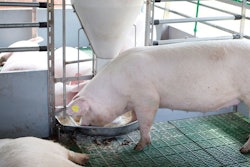
Multiple livestock species could be at risk of contracting COVID-19, according to genetic study
Multiple livestock species share a genetic risk for contracting the novel coronavirus (COVID-19), according to a new study from the University of California, Davis, but researchers say more work is needed to determine exactly what that risk means for producers.
SARS-CoV-2, the specific virus responsible for causing COVID-19, uses certain receptors on cells to gain entry and eventually cause disease. But multiple species — not just humans — have cellular receptors similar to the entry point preferred by COVID-19, which means dozens of animal species could be susceptible to the virus, according to UC Davis research published in the Proceedings of the National Academy of Sciences.
The UC Davis team behind the study used computers to compare the cells of 410 animal species to those of humans. Depending on the degree of similarity, species were classified according to the likelihood that they could contract COVID-19.
Species with obvious similarities to humans such as chimpanzees and gorillas had the most cellular receptors in common, and therefore the highest risk of contracting COVID-19, according to Joana Damas, a postdoctoral research associate at UC Davis and the lead author on the report. However, there were also some surprises: Deer and dolphins also share a high risk of susceptibility to COVID-19.
Several livestock species also made the list, with cattle, sheep and goats all showing a moderate level of risk of developing COVID-19. Pigs appear to have a low risk of susceptibility to the virus, and the risk for chickens is very low, Damas said.
Damas cautioned that the conclusions of the UC Davis report were based on computer models, and need to be backed up with studies of live cells that are currently in process. Cases of COVID-19 have so far been documented in mink, cats, dogs, hamsters, lions and tigers.
“We don’t want to spread panic around, because these are just computer-based predictions,” Damas said. “The main takeaway was there is a broad range of species predicted to have some risk of infection, and it’s important to monitor some of them just to be sure we don’t get any spillover from humans to those species.”
The study will also help researchers prioritize which species to study as they search for a possible origin of the virus. SARS-CoV-2 is believed to have originated in bats, Damas said, but scientists also believe it passed through an unknown intermediate host before it spread to humans.
View our continuing coverage of the novel coronavirus (COVID-19) pandemic.











